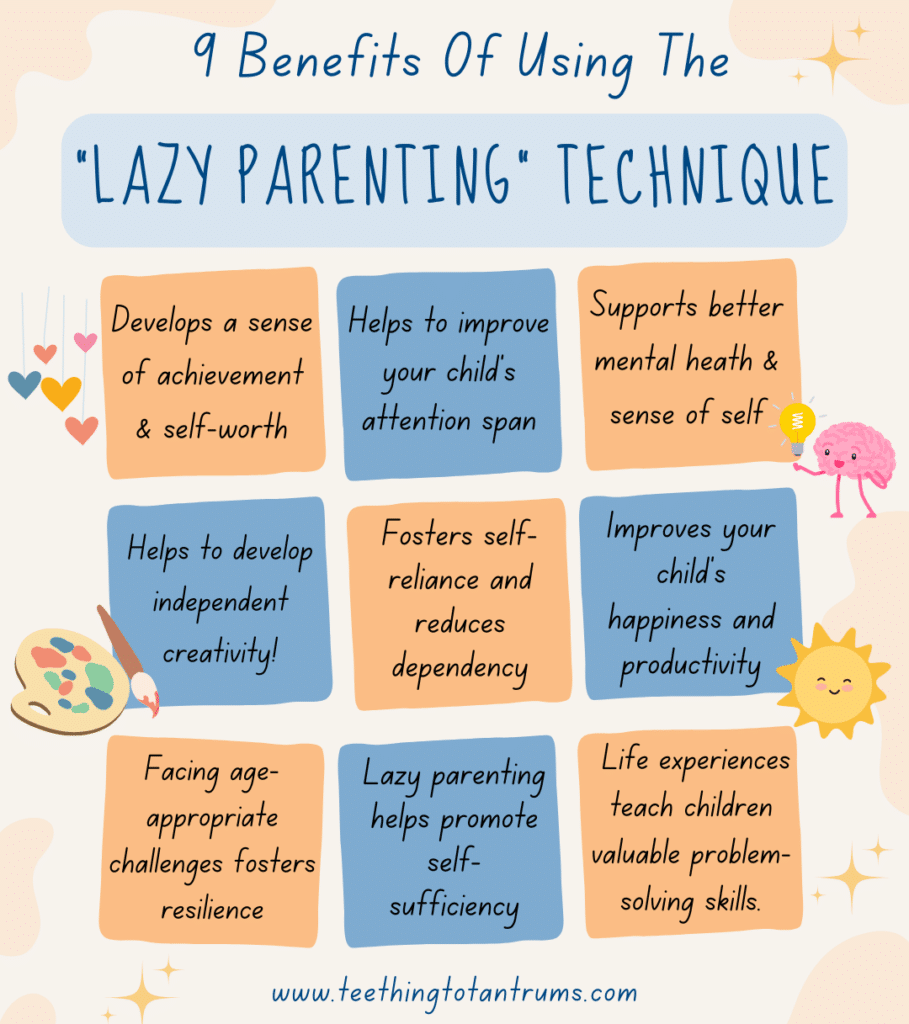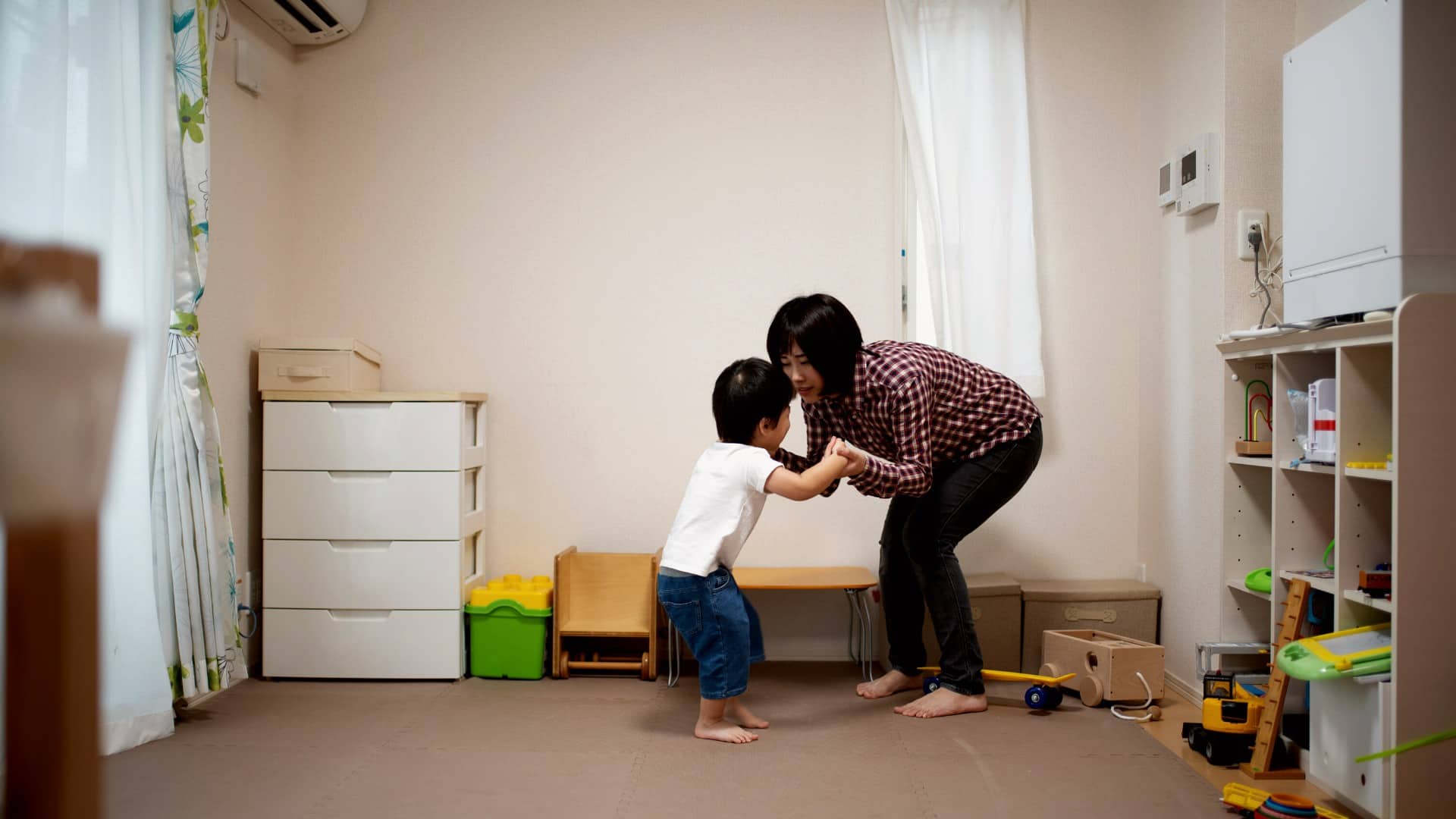Lazy parenting… is it actually lazy? Or is it one of the best parenting styles to follow?
Despite its name and misinterpretation, lazy parenting is not about neglect. Instead, lazy parenting is about helping your child build confidence and independence – striking a balance between intervention and freedom.
In today’s post, I will explain exactly what lazy parenting is, how it can benefit your child, and my tips for successfully implementing this parenting style. Ready to get started?

Table of Contents
What Is Lazy Parenting?
Lazy parenting is a style of parenting that aims to let young children face and solve their problems with minimal interference from parents and carers. The technique puts trust in your child’s ability to handle minor challenges and allows natural consequences to teach responsibility.
9 Benefits Of Lazy Parenting
Lazy parenting has been proven to positively influence various aspects of children’s development and, as a parenting style, can be very successful. Here are the top benefits:

- Builds Confidence and Self-Esteem: By allowing children to face and solve their own problems, they develop a sense of achievement and self-worth.
- Improves Attention Span: Children learn to focus and concentrate better when they are given the freedom to explore and manage tasks independently.
- Supports Better Mental Health and a Stronger Sense of Self: The autonomy provided by lazy parenting can lead to improved mental health and a more robust sense of identity.
- Develops Creativity: With less direct intervention, children are encouraged to think creatively and come up with their own solutions.
- Fosters Independence and Reduces Dependency: By stepping back, parents help their children become more self-reliant and less dependent on constant guidance.
- Improves Happiness and Productivity: Children who are allowed to navigate their own experiences tend to be happier and more productive.
- Fosters Resilience: Letting children face manageable difficulties helps them build resilience.
- Promotes Self-Sufficiency: Children learn to rely on themselves and their abilities.
- Strengthens Problem-Solving Skills: Real-life experiences teach children valuable problem-solving skills.
It is important to remember that lazy parenting doesn’t mean you’re uninvolved; it simply means you trust your little one to grow through their own experiences, with your supportive presence in the background as they navigate their world.
Essential Lazy Parenting Guidelines To Follow
The following list outlines lazy parenting guidelines. You may choose to adopt all of these principles, however, I have known many parents who only use some of them depending on their situation and the personality of their child.
These lazy parenting principles can adapt and fit into another parenting style that you are using to create a flexible hybrid approach.
- Set Boundaries. Lazy parenting does not mean letting your children rule the roost. You still need to establish clear boundaries for your children and they need to know what’s acceptable behavior and what’s not. Children also feel more confident when they know where their boundaries are.
- Let Them Figure It Out. A big principle of Lazy Parenting is to allow your children (whenever it is safely possible) to solve their own problems. By doing so, you will be helping your children build resilience and decision-making skills.
- Give Your Children Chores. I know that giving children chores has become quite controversial… BUT assigning age-appropriate chores to young children has been proven to teach responsibility, self-worth, and the understanding of an individual’s value of contributing to the household. I am an advocator of giving children age-appropriate chores, so if you would like to learn more about which chores are appropriate for your little one, read the following posts:
- Encourage Them To Take Responsibility. Encourage your children to take ownership of their actions. Understanding consequences helps develop accountability which is a valuable life skill.
- Step Back And Observe. Avoid intervening in every situation. Supervising from a distance is often enough to give your child the confidence to solve a problem or complete a task.
- Encourage Social Interaction. Let your children navigate social situations independently. Allow them to make mistakes and be awkward. Learning how to socialize takes time.
- Don’t Entertain 24/7. Putting your little one at the center of the universe all the time will curb their creativity and feed entitlement. Instead, share your time equally among your loved ones and let your child be bored from time to time. Being bored is a good thing. It encourages children to think independently and come up with new ideas.
- Use Natural Consequences. Children learn best from real-life experiences and allowing natural consequences to take place is one of life’s finest lessons.
Looking to get your little one to sleep quickly and effortlessly? Check out my Bedtime and Nap Cheat Sheet and master the art of making daytime naps and bedtimes as seamless as possible.
A bedtime & nap cheat sheet so good your little one will ask you to put them to bed...
Laura Williams "This is a life saver! I'm so glad I downloaded your bedtime & nap cheat sheet. My little one actually asked me to put him to bed last night! Unbelievable! Thank you so much!"
Click Here For The FREE Cheat Sheet
Downsides of Lazy Parenting
As with all styles of parenting, there are always pitfalls to be aware of, and it is wise to take into consideration your child’s personality and ability to function within any particular parenting style.
In the case of lazy parenting, without proper boundaries, some children might struggle to adjust to expectations and feel inadequate. It is also important that you follow the above guidelines to ensure that your child’s independence doesn’t turn into neglect.
When used wisely and in conjunction with other parenting principles, you can find a balanced approach that provides your child with freedom while setting boundaries to ensure safety and growth.
Tips For Implementing The Lazy Parenting Style
If you have decided that the lazy parenting style complements your parenting method, here are 8 top tips to ensure you and your little one get the most out of this parenting technique:

- Foster Independence. Whenever appropriate, give your little one the freedom to make decisions. Offer 2 choices when ordering at a cafe. Encourage your little one to order your drinks with the waiter. Let them choose a new T-shirt at the charity shop within a budget. Allow your child to navigate everyday challenges to boost resilience and build confidence.
- Encourage Open-Ended Play. Open-ended play is perfect for encouraging creativity and imagination. Structured activities are fine from time to time, but as a general rule offer toys that have no boundaries. Paints. Paper. Sidewalk chalk. A water bucket. Wooden kitchen utensils. A dressing-up box. Hours of fun!
- Let There Be Mess. Mess is a part of learning and exploring and being afraid to let our children make a mess will inhibit their creativity and problem-solving skills. What’s more important… your child learning a new skill and exploring their world… or trying to keep your kitchen looking spotless?
- Support Problem Solving. Rather than providing every solution, encourage your child to think critically. Help them solve an issue by asking questions that lead them to discover a problem-solving pathway. This applies to both physical and mental challenges your child is facing.
- Balance Involvement. While fostering independence, remain available for guidance. It’s crucial to intervene when necessary, especially if your child’s exploration poses risks or your little one is getting overly frustrated.
- Create Safe Spaces. Creating a space where your children can play and explore safely allows you to step back with peace of mind.
- Encourage Social Interaction. Arrange playdates and group activities regularly as frequent social interactions help your child develop interpersonal skills without your constant supervision.
- Be Patient. Understand that results won’t come immediately. Building independence and resilience takes time, so be patient with the process and let your little one take the lead.
My Opinion On Lazy Parenting
I am in favor of many aspects of lazy parenting because it encourages children to foster independence and responsibility, which is never a bad thing.
However, I never advocate for strictly following any single parenting technique, as all parents, families, and children are different. Therefore, your parenting styles will all be different too.
For children under five, I encourage allowing them to problem-solve by themselves before stepping in. Limiting frustration is key for this age range, so knowing when to step in and when to step back ensures your child gets the best out of any given situation.
As children grow, allowing them to participate in tasks like cooking or cleaning can teach time management and organization, as well as give them a sense of achievement.
Lazy parenting invests a lot in emotional intelligence, and when you allow young children to solve their own problems, it cultivates resilience and critical thinking. This approach undoubtedly produces capable individuals who are confident in navigating challenges.
The most difficult thing for many parents who implement the lazy parenting ethos is managing their own anxieties.
Our instinct as parents is to step in and solve issues to make life easier for our little ones. And whilst trusting your child to handle responsibilities can be tough, stepping back is crucial to letting them learn by doing.
Adopting a lazy parenting style doesn’t mean you’re uninvolved. You remain a guide and support for your child, ensuring they grow in a safe environment, and you step in when necessary, always on hand to offer advice and assistance if required.
Other Parenting Styles To Be Aware Of
There are several other parenting styles that you should know about. Each style has its own characteristics and impact on children.
- Helicopter Parenting is the complete opposite of Lazy Parenting and involves parents who are overly involved in their children’s lives. They often micromanage and make decisions for their children. This can lead to children feeling overprotected and lacking independence.
- Positive Parenting focuses on encouragement and positive reinforcement. It aims to build a strong relationship and encourage good behavior through positive interactions. This style promotes emotional intelligence and problem-solving skills.
- Authoritative Parenting combines high expectations with support and warmth. Parents set clear rules but provide reasons and consider their children’s opinions. This style is often associated with the best outcomes for children, including higher self-esteem and better social skills.
- Despite its similar name, Authoritarian Parenting is very different from Authoritative Parenting. Characterized by strict rules and high expectations with little warmth or feedback, Authoritarian Parenting is an intense parenting style. Discipline is often severe, and children are expected to obey without question. This can lead to lower self-esteem and social competence in children.
- Permissive Parenting is marked by a lenient approach, with few rules and limited discipline. Parents are nurturing but often fail to set boundaries. Children raised in this style may struggle with self-control and responsibility.
- Uninvolved Parenting represents a lack of responsiveness and minimal communication. Parents provide basic needs but are largely detached from their children’s lives. This can result in children feeling neglected and struggling with self-esteem.
- Gentle Parenting emphasizes respect, empathy, and understanding. It avoids harsh discipline and promotes a strong parent-child connection. This style encourages emotional development and cooperative behavior but can limit a child’s willingness to be independent.
As you can see, there are many different styles of parenting. You may focus on one, or a combination of several.
There is no right or wrong parenting style.
The best parenting style is the one that you are comfortable with and that your children thrive within.
For instance, I have found that Lazy Parenting works best when used with Positive Parenting and Authoritative Parenting.
Frequently Asked Questions About Lazy Parenting
This section addresses common questions about “lazy” parenting, including its comparison to other parenting styles, its potential to foster independence, its impact on development, and strategies to balance this approach.
Q: How does ‘lazy’ parenting compare to the established four parenting styles?
A: “Lazy” parenting is often compared to the established parenting styles: authoritative, authoritarian, permissive, and uninvolved. While authoritarian parents enforce strict rules, “lazy” parenting promotes a more relaxed approach. Some say it is more akin to permissive parenting but with more defined boundaries. Unlike uninvolved parenting, lazy parenting aims to encourage self-sufficiency, allowing children to explore independently.
Q: What is the opposite of lazy parenting?
A: The opposite of lazy parenting is helicopter parenting. While helicopter parents closely monitor and intervene, lazy parents step back, promoting self-reliance.
Q: Can ‘lazy’ parenting contribute positively to a child’s independence?
A: Yes, “lazy” parenting can foster independence. By stepping back, you allow your child to solve problems on their own. Children learn decision-making skills and gain confidence in their abilities. This approach encourages critical thinking and self-reliance.
Q: What are the potential impacts of ‘lazy’ parenting on a child’s development?
A: “Lazy” parenting can have diverse impacts on a child’s development. Children might become more resourceful and capable problem-solvers. They may also develop strong self-regulation skills. However, if boundaries are not put in place a lack of guidance might lead to increased screen time or missed learning opportunities. Being a Lazy Parent does not mean that you can be a disengaged one.
Q: What strategies can parents use to balance ‘lazy’ parenting while ensuring children’s needs are met?
A: To balance “lazy” parenting, establish clear rules and consistent routines. Encourage open communication, allowing your child to express their needs and feelings. Provide necessary support when they face challenges but resist the urge to micromanage.
Need More Parenting Help?
- Download our FREE Bedtime & Nap Sleep Cheat Sheet. It’s a free, easy-to-use and proven formula designed for parents of 0-5 year olds to master the art of consistently undisturbed and restful sleep without the yelling, nagging or exhausting long-winded evenings.
- Check out our Parenting Toolbox. You’ll get access to expertly-chosen products that you can guarantee are the best for your little one and your wallet.
- Are you looking for personalized guidance to navigate the challenges of parenting? I offer 1-on-1 consultations to bring you tailored strategies and actionable advice to help support your child's growth and well-being with confidence.

A bedtime & nap cheat sheet so good your little one will ask you to put them to bed...
Laura Williams "This is a life saver! I'm so glad I downloaded your bedtime & nap cheat sheet. My little one actually asked me to put him to bed last night! Unbelievable! Thank you so much!"
Click Here For The FREE Cheat Sheet


